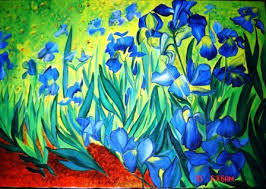Oil painting is the process of painting with pigments that are bound with a medium ofdrying oil. Commonly used drying oils include linseed oil, poppy
seed oil, walnut
oil, andsafflower oil.
The oil may be boiled with a resin, such as pine resin or frankincense to create a varnish; often prized for its body and gloss.
Different oils confer various properties to the oil paint, such as less yellowing or different drying times. Certain
differences are also visible in the sheen of the paints depending on the oil.
An artist might use several different oils in the same painting depending on
specific pigments and effects desired. The paints themselves also develop a
particular consistency depending on the medium.
Although oil paint was first used for the Buddhist Paintings by Indian and Chinese painters in western Afghanistan sometime between the fifth and tenth centuries, it did not gain popularity until the
15th century. Its practice may have migrated westward during the middle Ages.
Oil paint eventually became the principal medium used for creating artworks as
its advantages became widely known. The transition began with Early Netherlandish painting in northern Europe, and by the height of the Renaissance oil painting techniques had almost completely replaced tempera paints in the majority of Europe.
In recent years, water miscible
oil paint has come to prominence, to some extent replacing the usage
of traditional oils. Water soluble paints contain an emulsifier which allows them to be thinned with water (rather than
with paint thinner), and allows very fast drying times (1–3 days) when
compared with traditional oils (1–3 weeks).
Techniques
Traditional oil painting techniques often
begin with the artist sketching the subject onto the canvas with charcoal or
thinned paint. Oil paint is usually mixed with linseed oil, artist grade mineral spiritsor other solvents to create a thinner, faster or slower
drying paint. Because these solvents thin the oil in the paint, they can also
be used to clean paint brushes. A basic rule of oil paint application is 'fat
over lean'. This means that each additional layer of
paint should contain more oil than the layer below to allow proper drying. If
each additional layer contains less oil, the final painting will crack and peel.
There are many other media that can be used in oil painting, including cold
wax, resins, and varnishes. These additional media can aid the painter in
adjusting the translucency of the paint, the sheen of the paint, the density or
'body' of the paint, and the ability of the paint to hold or conceal the
brushstroke. These variables are closely related to the expressive capacity of
oil paint.
Traditionally, paint was transferred to the
painting surface using paint brushes, but there are other methods, including
using palette knives and rags. Oil paint remains wet longer than many other
types of artists' materials, enabling the artist to change the color, texture
or form of the figure. At times, the painter might even remove an entire layer
of paint and begin anew. This can be done with a rag and some turpentine for a
certain time while the paint is wet, but after a while, the hardened layer must
be scraped. Oil paint dries by oxidation, not evaporation, and is usually dry to the touch within a span of two
weeks. It is generally dry enough to be varnished in six months to a year. Art conservators do not consider
an oil painting completely dry until it is 60 to 80 years old.
Ingredients
The linseed oil itself
comes from the flax seed, a common fiber crop. It is
interesting to note that linen,
an important "support" for oil painting (see below) also comes from
the flax plant.Safflower oil, or
the more traditional walnut or poppy
seed, are sometimes used in formulating lighter colors such as white because it
"yellows" less on drying than does linseed oil, but it has the slight
drawback of drying more slowly.
Recent advances in chemistry have produced modern water miscible oil paints that can be used with and cleaned up
with water. Small alterations in the molecular structure of the oil create this water miscible property.
A still-newer type of
paint, heat-set oils, remain liquid until heated to 265–280 °F (130–138 °C) for about 15
minutes. Since the paint never dries otherwise, cleanup is not needed (except
when one wants to use a different color and the same brush). Although not
technically true oils (the medium is an unidentified "non-drying synthetic oily liquid, imbedded with a heat
sensitive curing agent"), the paintings resemble oil paintings and are
usually shown as oil paintings.

Thanks for sharing this useful info.. Malerei
ReplyDelete